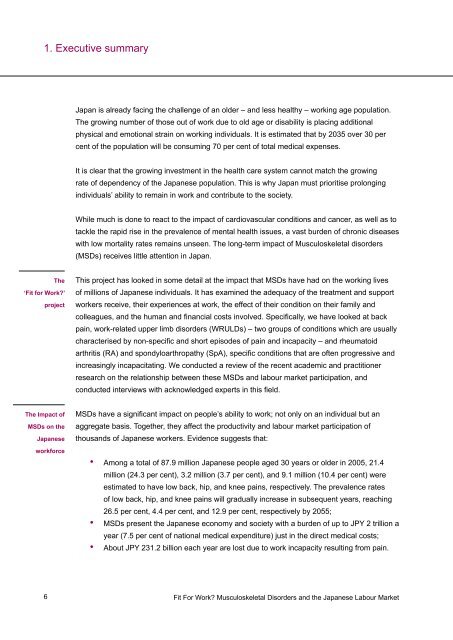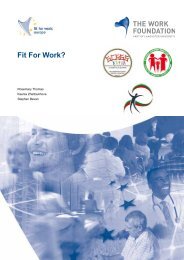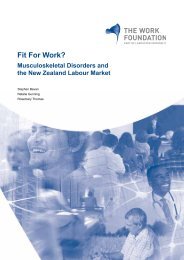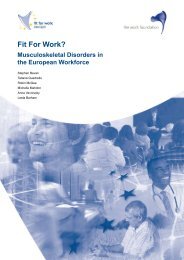English version - Fit for Work Europe
English version - Fit for Work Europe
English version - Fit for Work Europe
You also want an ePaper? Increase the reach of your titles
YUMPU automatically turns print PDFs into web optimized ePapers that Google loves.
1. Executive summary<br />
6<br />
The<br />
‘<strong>Fit</strong> <strong>for</strong> <strong>Work</strong>?’<br />
project<br />
The Impact of<br />
MSDs on the<br />
Japanese<br />
work<strong>for</strong>ce<br />
Japan is already facing the challenge of an older – and less healthy – working age population.<br />
The growing number of those out of work due to old age or disability is placing additional<br />
physical and emotional strain on working individuals. It is estimated that by 2035 over 30 per<br />
cent of the population will be consuming 70 per cent of total medical expenses.<br />
It is clear that the growing investment in the health care system cannot match the growing<br />
rate of dependency of the Japanese population. This is why Japan must prioritise prolonging<br />
individuals’ ability to remain in work and contribute to the society.<br />
While much is done to react to the impact of cardiovascular conditions and cancer, as well as to<br />
tackle the rapid rise in the prevalence of mental health issues, a vast burden of chronic diseases<br />
with low mortality rates remains unseen. The long-term impact of Musculoskeletal disorders<br />
(MSDs) receives little attention in Japan.<br />
This project has looked in some detail at the impact that MSDs have had on the working lives<br />
of millions of Japanese individuals. It has examined the adequacy of the treatment and support<br />
workers receive, their experiences at work, the effect of their condition on their family and<br />
colleagues, and the human and financial costs involved. Specifically, we have looked at back<br />
pain, work-related upper limb disorders (WRULDs) – two groups of conditions which are usually<br />
characterised by non-specific and short episodes of pain and incapacity – and rheumatoid<br />
arthritis (RA) and spondyloarthropathy (SpA), specific conditions that are often progressive and<br />
increasingly incapacitating. We conducted a review of the recent academic and practitioner<br />
research on the relationship between these MSDs and labour market participation, and<br />
conducted interviews with acknowledged experts in this field.<br />
MSDs have a significant impact on people’s ability to work; not only on an individual but an<br />
aggregate basis. Together, they affect the productivity and labour market participation of<br />
thousands of Japanese workers. Evidence suggests that:<br />
• Among a total of 87.9 million Japanese people aged 30 years or older in 2005, 21.4<br />
million (24.3 per cent), 3.2 million (3.7 per cent), and 9.1 million (10.4 per cent) were<br />
estimated to have low back, hip, and knee pains, respectively. The prevalence rates<br />
of low back, hip, and knee pains will gradually increase in subsequent years, reaching<br />
26.5 per cent, 4.4 per cent, and 12.9 per cent, respectively by 2055;<br />
• MSDs present the Japanese economy and society with a burden of up to JPY 2 trillion a<br />
year (7.5 per cent of national medical expenditure) just in the direct medical costs;<br />
• About JPY 231.2 billion each year are lost due to work incapacity resulting from pain.<br />
<strong>Fit</strong> For <strong>Work</strong>? Musculoskeletal Disorders and the Japanese Labour Market







